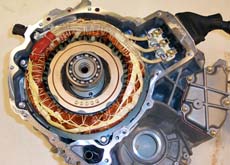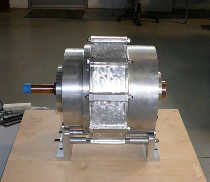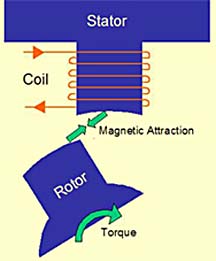
Motor efficiency has become a major specification in today's energy-conscious world. Small universal electric motors typically have an efficiency of about 30%, while 2-kW three-phase machines can reach efficiencies of 95% or higher — when they are operated at near full load.
Electric motors lose efficiency in several areas, the most common being copper losses, iron losses, stray losses, and mechanical losses. The efficiency level of an electric motor depends on actual electric motor load versus rated load. The highest efficiency occurs near the rated load and falls off rapidly for under- and over-load conditions. This is why proper motor sizing is needed for greatest efficiency.
This is true for the many electric automobiles available now. Efficiency means range as well as their very important effective MPG figure. A few key automotive motors:
Fiat goes electric
The Fiat 500e is powered by a 111-hp (83-kW) electric motor and floor-mounted 24-kWh lithium-ion battery pack that provide up to 80 miles (129 km) of range (100 miles/161 km in the city), 147 lb-ft of torque and a top speed of 85 mph (137 km/h). The battery pack will take less than four hours to charge with a 240-V Level 2 charger or about 24 hours with a 120-V charger. The 500e is about 500 lbs heavier than a regular 500 and the liquid-cooled, lithium-ion battery makes up about 600 of those pounds.
The Prius motor
The Toyota Prius uses synchronous ac permanent magnet motor, as do most hybrid vehicle manufactures. It has a maximum output of 50 kW between 1,200 and 1,540 rpm and a maximum torque of 400 Nm between 0 and 1,540 rpm. There are actually a pair of electric motor-generators combining into the electric equivalent of a continuously variable transmission. Hybrid Synergy Drive system combines these with a 1.8-liter four-cylinder gas engine. In the most recent third generation version, the inverter, motor, and transaxle combination is 20% lighter.

The main Prius electric motor
Interestingly, Toyota chose to get the motor for their new Rav4 EV from Tesla – a 154 HP AC induction motor. We had an earlier report that covered Tesla motor designs, Motors and rare-earth magnetic materials in October 2012.
The Ford Fusion hybrid
The FORD Energi hybid car uses a 141-hp-at-6,000-rpm gas engine along with a permanent magnet ac synchronous type motor/generator with an output power of 118 hp (88 KW) at 6,000 RPM and torque of 117 lb.-ft. Ford says combined power is 188 hp (not sure how that math works out). It combines with an eCVT hybrid powersplit transaxle and a 7.6-kWh Li-ion battery. Charge time is just 2.5 hours from 240 V (7 hours from 120 V).
The Venturi speed king
French automaker Venturi makes specialized turbocharged cars and unique electric transporters. Now it is going for speed, partnering with the Ohio State University. The team aims to take its VBB-3 battery-electric land speed car to Bonneville, where it hopes to break 700 km/h (434 mph). According to Drive.com.au, the VBB-3 uses a 2,230-kW electric motor, or 2,990 hp.

http://en.vbb3.venturi.fr/about/the-car
The GE traction motor
General Electric engineers have successfully tested a prototype hybrid and electric vehicle motor with a peak power level of 55 kW and the ability to operate continuously at up to 105°C (221°F), using conventional transmission fluid as the motor's sole cooling agent.
The motor, which GE says is 3% to 5% more efficient than existing motors, could potentially extend the range of a plug-in vehicle. It was developed as part of a $5.6-million U.S. Department of Energy project, and performs well over a range of bus voltages, from 200 to 650 V.

Traction motor research from GE
The permanent-magnet motor uses a concentrated (solenoidal) winding, and is extremely compact, with a stator diameter of approximately 9.2 inches and a length of 5 in. Power density is about twice that of today's motors, according to GE.
The motor can use a transaxle's fluid to cool both the rotor and the stator, producing a continuous 30 kW of output over a range of 2,800 to 14,000 rpm at 105°C. Alternatively, the motor can use a hybrid vehicle's engine coolant to limit operating temperature, rather than a separate, dedicated coolant loop.
GE also developed new high-resistivity magnets for the motor, which reduce magnetic losses and reduce or eliminate the need to use more costly segmented magnets. General Electric has discussed licensing the motor technology with electric motor manufacturers as well as automakers, and hopes to see commercial application in the automotive sector by 2015.
Next steps include a four-year project during which time GE engineers will seek to produce a motor with similar performance characteristics, yet with no rare-earth magnets.
A Honda transverse flux motor
Honda has proposed and is developing a transverse flux motor to shorten the axial length of the motor for hybrid electric vehicles. At the 2013 SAE World Congress, Honda engineers described their progress in improving the new type of three-dimensional magnetic circuit motor.
In contrast to conventional stators with a stator core of magnetic steel sheet and winding wires, the TF motor's stator is composed of a soft magnetic composite core and a coil. While reducing axial length and achieving a simple stator architecture comprising only five parts, the new motor raises issues including the need further to improve motor efficiency (currently at 83.7%) and the development of techniques for the manufacture of rectangular wave-shaped coils.
Switched reluctance motor R & D
Cobham Technical Services is collaborating with Jaguar Land-Rover (JLR) and engineering consultancy Ricardo UK to develop a switched reluctance drive motor. The project is partly funded by the UK Technology Strategy Board.
There is an urgent need to cut the use of rare earth elements in hybrid/electric vehicle drive motors. The materials are in short supply and have risen ten-fold in cost in recent years.
Most electric propulsion motors currently used are permanent magnet motorsand use magnets made from neodymium-iron-boron or samarium-cobalt. Since switched reluctance motors (SRM) do not use permanent magnets, they could provide an ideal replacement technology.
A switched-reluctance motor produces torque purely through interaction of the stator field with rotor saliency. The stator is laminated iron with stator poles and windings. The rotor is just laminated iron. By exciting a pair of opposing stator windings, the principle of reluctance will cause a torque to align the rotor poles with the stator poles.
Torque is produced by the magnetic attraction of a steel rotor to stator electromagnets; there are no permanent magnets. A controller energizes each stator winding only when it can produce useful torque. With suitable timing of the stator excitation, the machine can operate as a motor or generator. Switched reluctance motors are simple, robust and can offer very good efficiency over a wide load range. However, their drive electronics are not simple and need to deal with the changing inductance of the windings, depending on the rotor position.
While SRMs can have very high power density at low cost, they do have issues with high torque ripple when operated at low speed and the acoustic noise caused by torque ripple.

Basic mechanism of a SRM Source: Nidec
In the project Cobham will develop multi-physics software and capture the other partners' methodology in order to design, simulate and analyze the performance of high efficiency, lightweight switched reluctance traction motors. Using these new software tools JLR and Ricardo will design and manufacture a prototype SRM that addresses the requirements of luxury hybrid vehicles.
Efficient motors for industry
California the Sacramento Municipal Utility District contracted for an efficiency study of a 3-hp brushless permanent magnet motor developed by NovaTorque. The Premium Plus+ 3 HP motor system includes a motor and a variable speed drive. The motor's performance as an energy efficiency technology was evaluated using laboratory testing for a SMUD initial technology assessment.
Since fan systems are moving toward variable speed, the question of efficiency at various speeds and loads is more important.

Efficiency vs speed for three versions of a BLDC motor
The testing determined that, in a basic fan application, the new motor would save 14 to 16% of the operating costs, over a standard ac motor and 10% to 12% over a high-efficiency ac motor.
The NovaTorque motor uses an axial flux path, flowing straight through the field poles of the stator, that allows the use of bobbin-wound coils. This creates a thermal path as one face of the coils is next to the external motor case, instead of being inside the lamination stack as is found in an induction motor.
Advertisement
Learn more about Electronic Products Magazine





